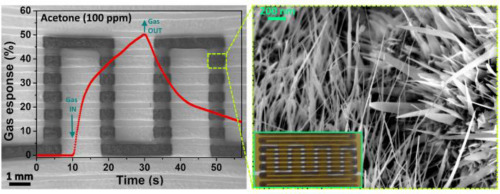Nano Energy ( IF 16.8 ) Pub Date : 2020-01-03 , DOI: 10.1016/j.nanoen.2019.104420 Leonard Siebert , Niklas Wolff , Nicolai Ababii , Maik-Ivo Terasa , Oleg Lupan , Alexander Vahl , Viola Duppel , Haoyi Qiu , Maik Tienken , Mattia Mirabelli , Victor Sontea , Franz Faupel , Lorenz Kienle , Rainer Adelung

|
In this work, a facile two step fabrication and characterization of 3D printed acetone sensors based on mixed semiconducting metal oxides is introduced. The devices are fabricated by Direct Ink Writing metal microparticle (MP) stripes of commercially available pure iron and copper particles onto the surface of a glass substrate, forming a bridging multi-phase semiconducting oxide net by subsequent thermal annealing. The open, highly porous bridging structures consist of heterojunctions which are interconnected via non-planar CuO/Cu2O/Cu nanowires and Fe2O3/Fe nanospikes. Morphological, vibrational, chemical and structural studies were performed to investigate the contact-forming Fe2O3-CuO nanostructures on the surface of the MPs. The power consumption and the gas sensing properties showed selectivity to acetone vapor at an operating temperature of around 300 °C with a high gas response of about 50% and the lowest operating power of around 0.26 μW to a concentration of 100 ppm of acetone vapor. The combination of the possibility of acetone vapor detection, the controllable size and geometry and their low power make these 3D-printed structures important candidates for next developments of accessible detection devices, as well as acetone vapor monitoring (even below 1 ppm). The printing of MPs in general paves the way for a new generation of printed different devices, even in “home-made” conditions, for a manifold of applications tailored by the composition and geometry of the printed MP stripes, enabled through the simplicity and versatility of the fabrication method.
中文翻译:

易写金属微粒的直接墨水书写可轻松制造半导体氧化物纳米结构及其在低功率丙酮气体传感器中的应用
在这项工作中,介绍了一种基于混合半导体金属氧化物的3D打印丙酮传感器的便捷两步制造和表征。通过将可商购的纯铁和铜颗粒的金属微粒(MP)条纹直接墨水书写在玻璃基板的表面上,并通过随后的热退火形成桥接多相半导体氧化物网,从而制造这些器件。开放的,高度多孔的桥接结构由异质结组成,异质结通过非平面的CuO / Cu 2 O / Cu纳米线和Fe 2 O 3 / Fe纳米钉相互连接。进行了形态,振动,化学和结构研究,以研究形成接触的Fe 2 O 3MP表面上的-CuO纳米结构。功率消耗和气体感应特性在约300°C的工作温度下显示出对丙酮蒸气的选择性,在浓度为100 ppm的丙酮蒸气下,气体响应高约50%,最低工作功率约0.26μW。丙酮蒸气检测的可能性,可控制的尺寸和几何形状及其低功耗的结合,使这些3D打印的结构成为可访问检测设备以及丙酮蒸气监测(甚至低于1 ppm)的下一步开发的重要候选对象。通常,MP的印刷为新一代印刷的不同设备铺平了道路,即使是在“自制”条件下,也为印刷的MP条带的组成和几何形状量身定制的多种应用铺平了道路,











































 京公网安备 11010802027423号
京公网安备 11010802027423号